2008 MERCEDES-BENZ A-CLASS HATCHBACK light
[x] Cancel search: lightPage 148 of 305
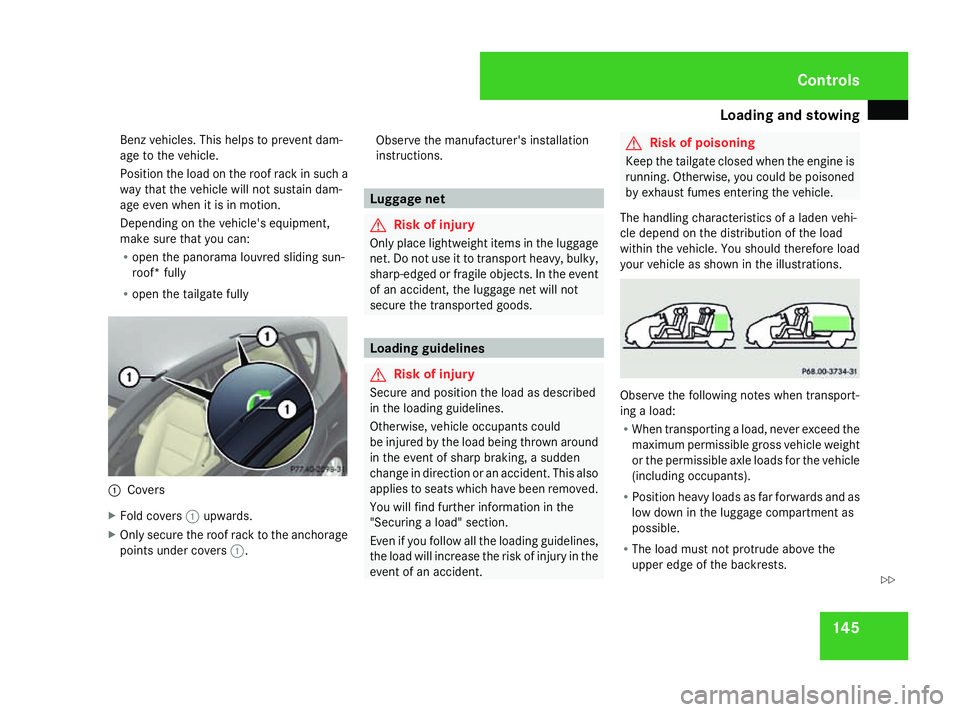
Loading and stowing
145
Benz vehicles. This helps to prevent dam-
age to the vehicle.
Position the load on the roof rack in such a
way that the vehicle will not sustain dam-
age even when it is in motion.
Depending on the vehicle's equipment,
make sure that you can:
R open the panorama louvred sliding sun-
roof* fully
R open the tailgate fully 1
Covers
X Fold covers 1upwards.
X Only secure the roof rack to the anchorage
points under covers 1. Observe the manufacturer's installation
instructions. Luggage net
G
Risk of injury
Only place lightweight items in the luggage
net. Do not use it to transport heavy, bulky,
sharp-edged or fragile objects. In the event
of an accident, the luggage net will not
secure the transported goods. Loading guidelines
G
Risk of injury
Secure and position the load as described
in the loading guidelines.
Otherwise, vehicle occupants could
be injured by the load being thrown around
in the event of sharp braking, a sudden
change in direction or an accident. This also
applies to seats which have been removed.
You will find further information in the
"Securing a load" section.
Even if you follow all the loading guidelines,
the load will increase the risk of injury in the
event of an accident. G
Risk of poisoning
Keep the tailgate closed when the engine is
running. Otherwise, you could be poisoned
by exhaust fumes entering the vehicle.
The handling characteristics of a laden vehi-
cle depend on the distribution of the load
within the vehicle. You should therefore load
your vehicle as shown in the illustrations. Observe the following notes when transport-
ing a load:
R
When transporting a load, never exceed the
maximum permissible gross vehicle weight
or the permissible axle loads for the vehicle
(including occupants).
R Position heavy loads as far forwards and as
low down in the luggage compartment as
possible.
R The load must not protrude above the
upper edge of the backrests. Controls
169_AKB; 2; 4, en-GB
wdomann
, Version: 2.10.6
2008-07-16T08:52:06+02:00 - Seite 145 ZDateiname: 6515_0315_02_buchblock.pdf; preflight
Page 149 of 305
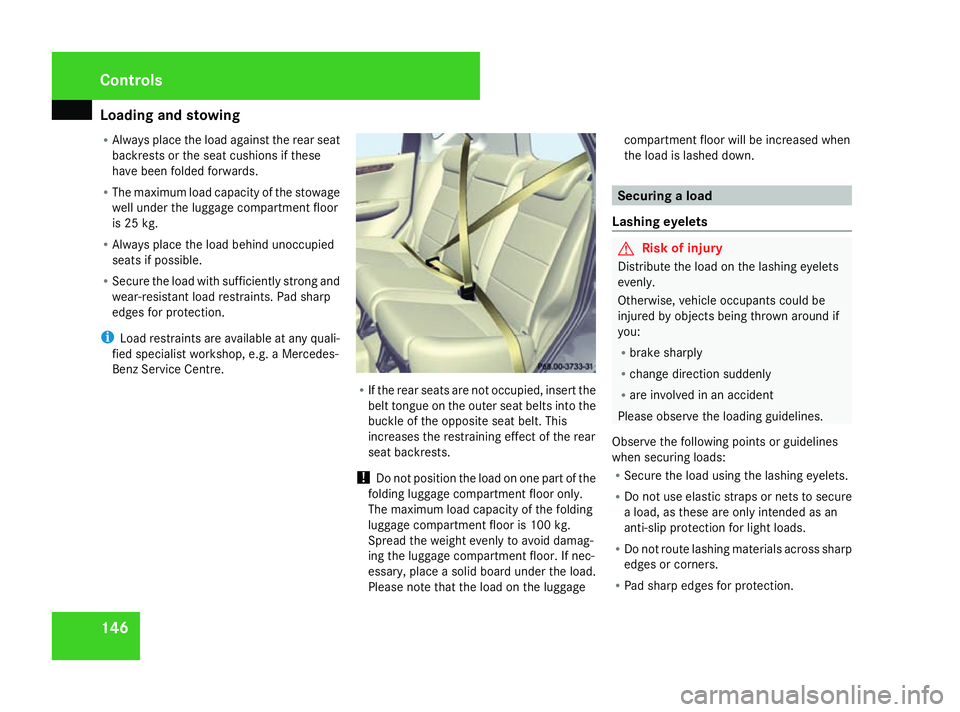
Loading and stowing
146
R
Always place the load against the rear seat
backrests or the seat cushions if these
have been folded forwards.
R The maximum load capacity of the stowage
well under the luggage compartment floor
is 25 kg.
R Always place the load behind unoccupied
seats if possible.
R Secure the load with sufficiently strong and
wear-resistant load restraints. Pad sharp
edges for protection.
i Load restraints are available at any quali-
fied specialist workshop, e.g. a Mercedes-
Benz Service Centre. R
If the rear seats are not occupied, insert the
belt tongue on the outer seat belts into the
buckle of the opposite seat belt. This
increases the restraining effect of the rear
seat backrests.
! Do not position the load on one part of the
folding luggage compartment floor only.
The maximum load capacity of the folding
luggage compartment floor is 100 kg.
Spread the weight evenly to avoid damag-
ing the luggage compartment floor. If nec-
essary, place a solid board under the load.
Please note that the load on the luggage compartment floor will be increased when
the load is lashed down. Securing a load
Lashing eyelets G
Risk of injury
Distribute the load on the lashing eyelets
evenly.
Otherwise, vehicle occupants could be
injured by objects being thrown around if
you:
R brake sharply
R change direction suddenly
R are involved in an accident
Please observe the loading guidelines.
Observe the following points or guidelines
when securing loads:
R Secure the load using the lashing eyelets.
R Do not use elastic straps or nets to secure
a load, as these are only intended as an
anti-slip protection for light loads.
R Do not route lashing materials across sharp
edges or corners.
R Pad sharp edges for protection. Controls
169_AKB; 2; 4, en-GB
wdomann,
Version: 2.10.6 2008-07-16T08:52:06+02:00 - Seite 146Dateiname: 6515_0315_02_buchblock.pdf; preflight
Page 150 of 305

Loading and stowing
147
Securing loads in the luggage compart-
ment
There are four lashing eyelets in the luggage
compartment. Example: 5-door vehicle
1
Lashing eyelets
X Secure the load using lashing eyelets 1or
the mounting cups for the seats, if the seats
have been removed. Securing a load when the seats have been
removed Rear seat removed
X
Guide the load restraints in a cross pattern
over the load, as shown in the illustration.
X Secure the load using the lashing eyelets
or the mounting cups on the seats. G
Risk of injury
Always stow the load so that it does not
interfere with driving the vehicle.
Avoid obstructing the driver's line-of-sight.
The load must not protrude above the upper
edge of the door trim if the front-passenger
seat has been removed.
Pad sharp edges for protection. This will
reduce the risk of lacerations and prevent
the load restraints from wearing.
Observe the following notes: R
The load must not protrude above the
upper edge of the door trim.
R Long loads must only be placed low down
and towards the front of the front-
passenger footwell.
! Load restraints must not be fastened to
the front right-hand mounting cup. Other-
wise, the contact switch for the front-
passenger seat could be damaged.
Securing a light load using a retaining
net*
X Place the retaining net over the load.
X Engage the retaining net hooks in the lash-
ing eyelets. Through-loading feature*
G
Risk of injury
Do not transport unsecured objects in the
through-loading facility.
Otherwise, you and other vehicle occu-
pants could be injured by objects being
thrown around the vehicle in the event of
sharp braking, a sudden change in direction
or an accident. Controls
* optional
169_AKB; 2; 4, en-GB
wdomann , Version: 2.10.6 2008-07-16T08:52:06+02:00 - Seite 147 ZDateiname: 6515_0315_02_buchblock.pdf; preflight
Page 151 of 305
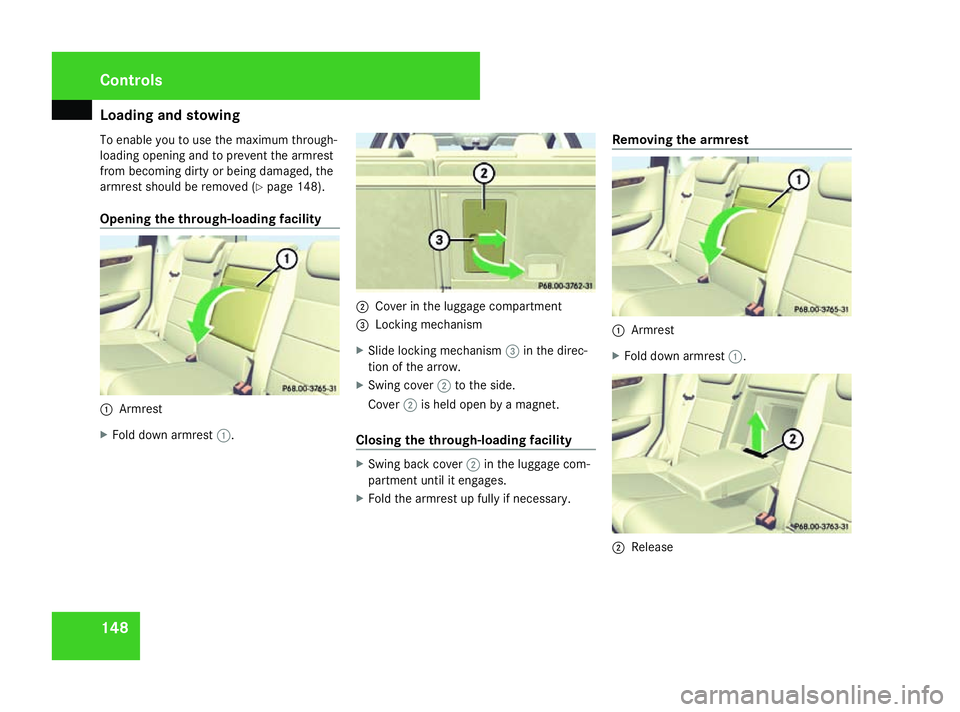
Loading and stowing
148
To enable you to use the maximum through-
loading opening and to prevent the armrest
from becoming dirty or being damaged, the
armrest should be removed (Y page 148).
Opening the through-loading facility 1
Armrest
X Fold down armrest 1. 2
Cover in the luggage compartment
3 Locking mechanism
X Slide locking mechanism 3in the direc-
tion of the arrow.
X Swing cover 2to the side.
Cover 2is held open by a magnet.
Closing the through-loading facility X
Swing back cover 2in the luggage com-
partment until it engages.
X Fold the armrest up fully if necessary. Removing the armrest 1
Armrest
X Fold down armrest 1. 2
Release Controls
169_AKB; 2; 4, en-GB
wdomann,
Version: 2.10.6 2008-07-16T08:52:06+02:00 - Seite 148Dateiname: 6515_0315_02_buchblock.pdf; preflight
Page 152 of 305
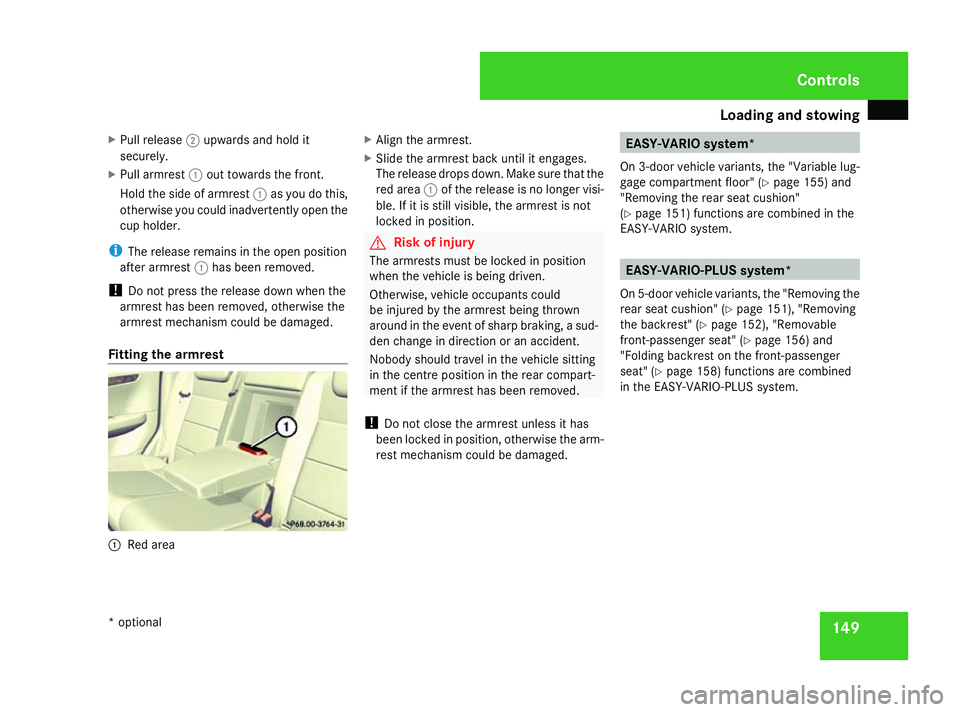
Loading and stowing
149
X
Pull release 2upwards and hold it
securely.
X Pull armrest 1out towards the front.
Hold the side of armrest 1as you do this,
otherwise you could inadvertently open the
cup holder.
i The release remains in the open position
after armrest 1has been removed.
! Do not press the release down when the
armrest has been removed, otherwise the
armrest mechanism could be damaged.
Fitting the armrest 1
Red area X
Align the armrest.
X Slide the armrest back until it engages.
The release drops down. Make sure that the
red area 1of the release is no longer visi-
ble. If it is still visible, the armrest is not
locked in position. G
Risk of injury
The armrests must be locked in position
when the vehicle is being driven.
Otherwise, vehicle occupants could
be injured by the armrest being thrown
around in the event of sharp braking, a sud-
den change in direction or an accident.
Nobody should travel in the vehicle sitting
in the centre position in the rear compart-
ment if the armrest has been removed.
! Do not close the armrest unless it has
been locked in position, otherwise the arm-
rest mechanism could be damaged. EASY-VARIO system*
On 3-door vehicle variants, the "Variable lug-
gage compartment floor" (Y page 155) and
"Removing the rear seat cushion"
(Y page 151) functions are combined in the
EASY-VARIO system. EASY-VARIO-PLUS system*
On 5-door vehicle variants, the "Removing the
rear seat cushion" ( Ypage 151), "Removing
the backrest" (Y page 152), "Removable
front-passenger seat" (Y page 156) and
"Folding backrest on the front-passenger
seat" (Y page 158) functions are combined
in the EASY-VARIO-PLUS system. Controls
* optional
169_AKB; 2; 4, en-GB
wdomann,
Version: 2.10.6 2008-07-16T08:52:06+02:00 - Seite 149 ZDateiname: 6515_0315_02_buchblock.pdf; preflight
Page 153 of 305
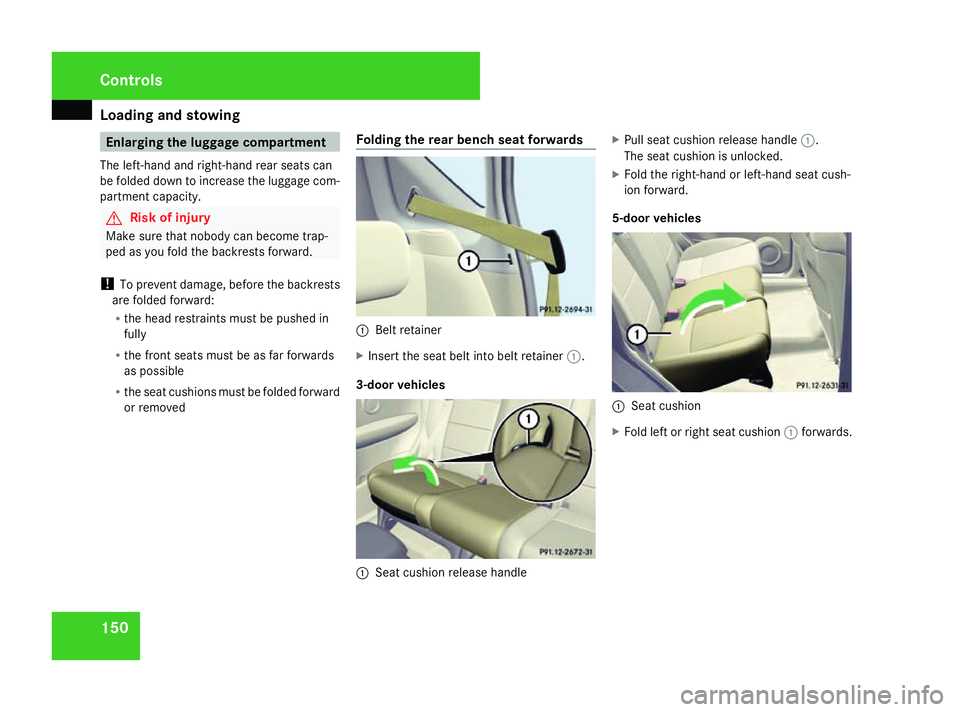
Loading and stowing
150 Enlarging the luggage compartment
The left-hand and right-hand rear seats can
be folded down to increase the luggage com-
partment capacity. G
Risk of injury
Make sure that nobody can become trap-
ped as you fold the backrests forward.
! To prevent damage, before the backrests
are folded forward:
R the head restraints must be pushed in
fully
R the front seats must be as far forwards
as possible
R the seat cushions must be folded forward
or removed Folding the rear bench seat forwards 1
Belt retainer
X Insert the seat belt into belt retainer 1.
3-door vehicles 1
Seat cushion release handle X
Pull seat cushion release handle 1.
The seat cushion is unlocked.
X Fold the right-hand or left-hand seat cush-
ion forward.
5-door vehicles 1
Seat cushion
X Fold left or right seat cushion 1forwards. Controls
169_AKB; 2; 4, en-GB
wdomann,
Version: 2.10.6
2008-07-16T08:52:06+02:00 - Seite 150 Dateiname: 6515_0315_02_buchblock.pdf; preflight
Page 154 of 305

Loading and stowing
151
3 and 5-door vehicles
2
Backrest release handle
3 Backrest
X Pull left-hand or right-hand release handle
2 on backrest.
Corresponding backrest 3is unlocked.
X Fold the backrest forwards until it rests on
the hinge fixtures (Y page 152).
X Move the front seats to the desired posi-
tions. Swinging back the rear bench seat 4
Red lock verification indicator
X Swing the backrest back until it engages.
Red lock verification indicator 4is no lon-
ger visible.
! Make sure that the seat belt does not
become trapped.
X Swing the seat cushion backwards.
X Adjust the head restraints if necessary .
X Move the front seats to the desired posi-
tions.
If red lock verification indicator 4is visible,
this means the backrest is not engaged. G
Risk of injury
Make sure that the backrest is correctly
locked in position. The red lock verification
indicators on the left and right sides should
no longer be visible. If they are visible, the
backrests are not locked in position.
Occupants could then be injured in the
event of an accident, e.g. by objects being
thrown forwards from the luggage com-
partment.
Removing rear seat cushions* 1
Belt retainer
X Insert the seat belt into belt retainer 1. Controls
169_AKB; 2; 4, en-GB
wdomann
, Version: 2.10.6 2008-07-16T08:52:06+02:00 - Seite 151 ZDateiname: 6515_0315_02_buchblock.pdf; preflight
Page 155 of 305

Loading and stowing
1521
Seat cushion
X Fold left or right seat cushion 1forwards. 2
Release handle
3 Seat cushion X
Grasp release handle 2and pull seat cush-
ion 3upwards.
X Remove seat cushion 3. 4
Hinge
X If the backrest is to be removed: fold down
hinge 4.
If the backrest is only to be folded down:
leave hinge 4as a support for the backrest
in the position shown above.
i Vehicles with TIREFIT kit:
You can stow the seat cushions under the
variable luggage compartment floor*.
Vehicles with emergency spare wheel:
You can stow a seat cushion under the var-
iable luggage compartment floor*. !
Vehicles with emergency spare wheel*,
loud speaker system* or sound system*:
You cannot stow any seat cushions under
the variable luggage compartment floor*.
Fitting rear seat cushions* X
Fold hinge 4upwards if necessary. Only
then can the seat cushion be slid in.
X Slide the seat cushion onto the fixtures
until it engages.
i For easier alignment of the cushions,
observe the arrows on the rear of the seat
cushions.
X Swing the seat cushion back.
Removing the backrests* X
Fold the seat cushion forwards
(Y page 151). Controls
169_AKB; 2; 4, en-GB
wdomann
, Version: 2.10.6
2008-07-16T08:52:06+02:00 - Seite 152 Dateiname: 6515_0315_02_buchblock.pdf; preflight